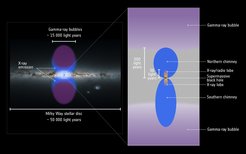X-ray Chimneys in the Milky Way
Outflows of matter and energy from a galaxy’s centre are considered key players in the formation and evolution of galaxies and other structures in the Universe. Astronomers led by the Max Planck Institute for Extraterrestrial Physics have now created the most extensive X-ray map of the central degrees of the Milky Way, thereby discovering a channel of X-ray emitting gas connecting the Milky Way centre to structures much further out.
Our home galaxy, the Milky Way, is a rather quiescent galaxy; gigantic energy outbursts from the galactic centre are rare. Nevertheless, close to the centre, marked by the radio source Sagittarius A*, astronomers have found bipolar lobes that can be seen in both radio and X-ray emission, indicating outflows from the galactic centre to distances of about 50 lightyears (15 parsec). Much further out, gamma-ray observations have identified the so-called "Fermi bubbles" with radiation from particles at relativistic speed, implying that in the past our galaxy experienced a period of huge energy release.

This false colour image shows X-ray emission from the central 300 by 500 parsecs of the Milky Way. The colours indicate different energy levels of the X-ray emission. A coherent, shell-like feature is visible both north and south of the galactic plane, the so-called “chimneys”, connecting the inner region around the supermassive black hole at the centre (located in the white area at the middle) with the Fermi Bubbles much further out. Point sources and very bright sources have been removed.
An international team of astronomers led by the Max Planck Institute for Extraterrestrial Physics (MPE) have now discovered two prominent X-ray structures on intermediate scales, which seem to connect the Galactic centre region to the Fermi bubbles. “A few years back, thanks to observations in the X-ray band, we discovered the presence of an overdensity of hot plasma right above the Galactic center, a puzzling finding. Therefore, we now scanned a significantly larger region with the European X-ray satellite XMM-Newton," explains Gabriele Ponti, lead author of the paper now published in Nature. "With our new observations we were not only able to clearly confirm the presence of such hot plasma, but also to measure its morphology, discovering two X-ray emitting features, extending for hundreds of parsecs north and south of the Galactic center."
Most probably these "Chimneys" are made up of a fast and cold gas stream perpendicular to the galactic plane, an outflow that could be powered either by stars disrupted by the massive black hole at the centre of the galaxy, or supernova explosions in the central star cluster. Such episodic events could lead to a quasi-continuous injection of energy and mass, which would then be transported from the central region to the base of the Fermi bubbles.
"The chimneys are roughly cylindrical in shape and have sharp edges along their vertical direction, most likely contained by magnetic pressure," remarks Florian Hofmann, MPE. "The two chimneys are not strictly symmetric, which is most likely a result of local "galactic weather", an interaction with local clouds of the interstellar medium."

“While on the largest scales the Fermi bubbles are reminiscent of structures created by energetic outflows from supermassive black holes in galaxy clusters, the Chimneys’ appearance leaves open the possibility that less violent processes play a role,” adds Eugene Churazov, from the Max Planck Institute for Astrophysics.
Even with this as the most extensive X-ray map of the central degrees of the Milky Way, the X-ray data does not directly support the idea that the Chimneys are a continuation of the inner lobes. These could represent just the latest energy injection into the Chimneys or it could be two nested outflows. Nevertheless, these Chimneys and their observed properties clarify the link between activity in the core of the Milky Way and macroscopic structures on galactic scales, likely affecting the formation and evolution of the Milky Way itself - even shedding light on the physics of outflows and their impact on galaxies in general.













